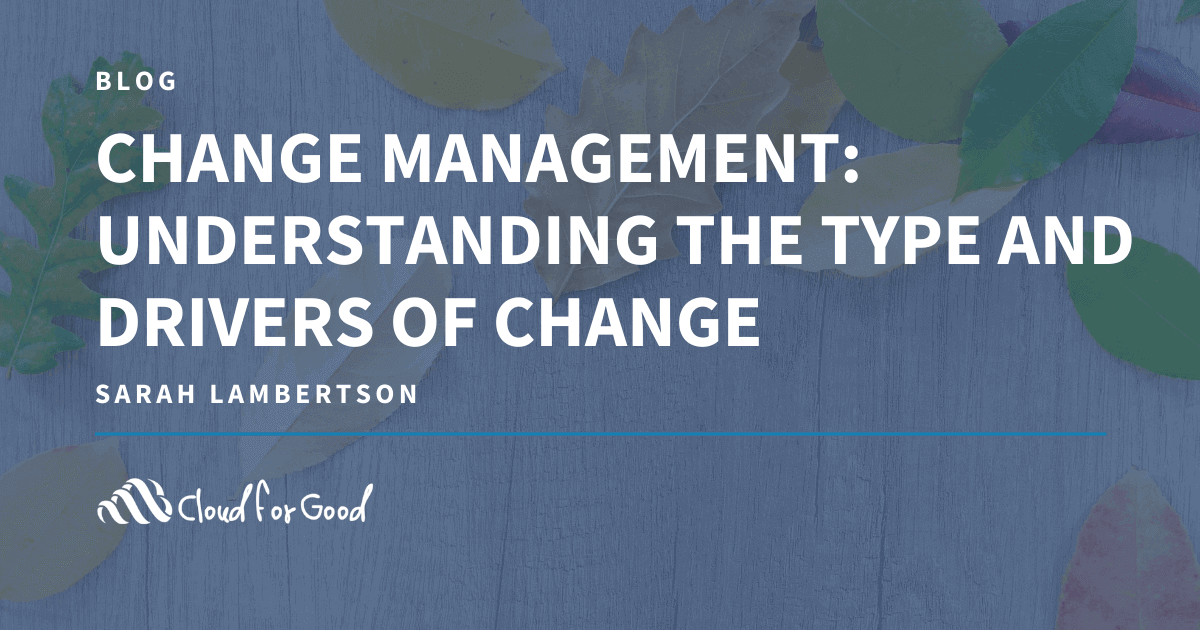Change is inevitable and one of the main forces behind improvement, strength and progress. For nonprofits, change, especially in technology, can be a game-changer. I’m a pretty firm believer in the power of Salesforce. Whether you’re considering a switch from a legacy Constituent Relationship Manager (CRM) to Salesforce or looking to conduct a major upgrade of your current instance, understanding the driving motivation for that change can be helpful. It pushes you to prepare for the TYPE of change your organization will undergo.
Without this understanding, it is possible to find yourself in a situation where you have built the “perfect” system, yet nobody who is willing to use it. User adoption goes hand-in-hand with how well the leader understands the need and process of change, and how well that process is communicated throughout.
What Drives Changes?
To understand your change, you’ll first want to look at what drives it. Understanding these drivers can help you identify what type of change you are dealing with. This is crucial because if there is misalignment internally, or miscommunication about the scope or need for change, it can make the process of executing that change difficult for all involved.
Anderson and Anderson (2001) identify 7 primary drivers of change, starting with external forces and moving to internal forces.
External: These drivers are ones that leaders are more familiar with and will often think of first when determining the underlying cause of the change and the extent of the impact of the change. External drivers can include a need to change to meet the changing needs/demands of stakeholders, or perhaps to align internal systems to reduce overhead costs and allow for a more internal flow of information.
- Environment
- Marketplace Requirements for Success
- Business Imperatives
- Organizational Imperatives
Internal: These drivers are harder to identify and articulate, but if they are not attended to, they could contribute to an unsuccessful project. Attending to both internal and external drivers is key to success. Too much focus on one can lead to challenges.
- Cultural Imperatives
- Leader and Employee Behavior
- Leader and Employee Mindset
Most project will have an external driver that initiates the need for change, but frequently, that external driver will trigger an internal driver as well. For an organization switching from a legacy platform or moving from excel to Salesforce, the primary driver is a need to optimize operational efficiency and meet the needs of your clients/donors/volunteers/stakeholders. While it is tempting to say the change is nothing more than that, it is important to think about the internal impact this change will have within your organization. If you find yourself and others saying: “this is just how we do it”, it might be time to understand the needed behavior and mindset change that accompanies the system upgrade.
While some business processes have been refined and honed over the years, there are likely others that have been inherited through generations of employees brought about by limitations of a current system. Taking the time to understand which business processes are well curated and which are “just because” is the start. The next part of the process is making sure those people impacted by the updated business processes are onboard and part of defining the new process.
Featured Content

I founded Cloud for Good over 10 years ago and have witnessed firsthand a number of high-impact releases within the Salesforce ecosystem. Today, Salesforce.org announced

Poverty, homelessness, health, and the general well-being of individuals and the collective: no matter what your Human Service organization’s mission
Different Types of Change
All change isn’t created equal. After you’ve thought about what factors are driving your change, you can then think about what type of change your organization needs. The three most common types of changes include:
- A developmental change is the easiest to manage as it is primarily just an improvement of your current state. Perhaps this is an upgrade to Lightning when you’ve already been using Salesforce or another upgrade to the system without major structural changes to the way your team works.
- A transitional change is moving from a current state to a new state to fix a clearly identified problem. If the desired end state is clearly defined before starting the work, the change is transitional and does not require a major mindset shift. This type of change sounds deceptively simple because even though you have a clearly defined end point in mind, you will need to think about the behavior and mindset shifts required.
- A transformational change is driven by a need for survival. With a transformational change, the end state is not known at the start of the process. This type of change is hard to manage and requires major mindset shifts. It’s possible your decision to come to Salesforce is part of a larger transformational change at your organization. Transformational change is hard and messy, but when survival is on the line, change is the only option.
Being able to recognize the further reaching implications for a Salesforce integration is critical to success. While a system change, or upgrade, can appear to be a purely IT project with external drivers, there is almost certainly a needed internal change as well. Taking the time to understand the drivers and types of change at the onset of a project can help set you up for success.
Want to read more about this topic?





